From the Wichita Pachyderm Club this week: David Kensinger, President of Kensinger and Associates. His topic was “The Early Returns of the 2020 Presidential Election.” This audio presentation was recorded on August 2, 2019.


From the Wichita Pachyderm Club this week: David Kensinger, President of Kensinger and Associates. His topic was “The Early Returns of the 2020 Presidential Election.” This audio presentation was recorded on August 2, 2019.

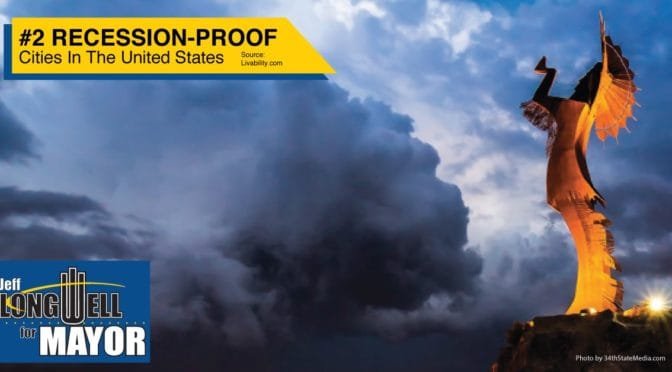
The City of Wichita and Mayor Jeff Longwell shouldn’t be using flimsy evidence that is contrary to actual economic data.
Earlier this year Wichita city officials promoted an article that praised the Wichita economy. 1 A tweet came from the official @CityofWichita Twitter account and reads “We have been named one of the top two recession-proof cities in the nation by @Livability. Wichita was praised for its ability to withstand turbulence in the national economy, steady job growth and the state’s low income-to-debt ratio.” 2
 Now Wichita Mayor Jeff Longwell is using this in his campaign to be reelected mayor.
Now Wichita Mayor Jeff Longwell is using this in his campaign to be reelected mayor.
The problem is that this claim of Wichita being recession-proof isn’t true. I explain in more detail in Wichita, a recession-proof city.
Here are two charts of actual economic data. The first chart shows the change in real gross domestic product for the Wichita metropolitan statistical area and the nation.

Notice that since the Great Recession ended in 2009, there have been three separate years in which Wichita GDP declined. Since a recession is defined as a period of declining GDP, Wichita is obviously not recession-proof.
As for the “ability to withstand turbulence in the national economy,” these three years of shrinking Wichita GDP were years when the national economy expanded.
As for “steady job growth,” here is a chart of annual job growth for the Wichita metropolitan statistical area and the nation.

Since the end of the Great Recession, there have been two years in which Wichita lost jobs while the nation was gaining jobs. This happened most recently in 2017, while Longwell was mayor. Since the end of the Great Recession, Wichita has created jobs at a much slower pace than the nation. Wichita has been doing better last year and this year, although recent months have shown a loss of jobs. 3
—
Notes
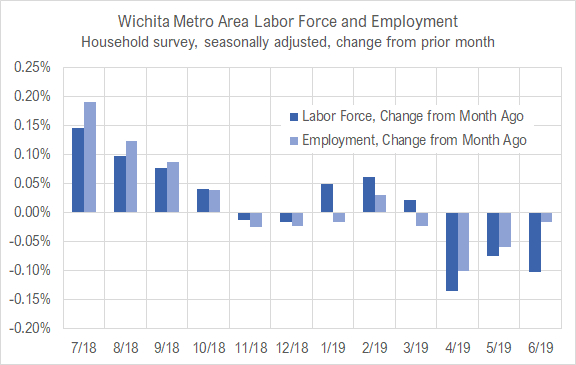
For the Wichita metropolitan area in June 2019, the labor force is up, the number of unemployed persons is up, the unemployment rate is down, and the number of people working is up when compared to the same month one year ago. Seasonal data shows declines in labor force and jobs from May.
Data released today by the Bureau of Labor Statistics, part of the United States Department of Labor, shows a slowing employment situation for the Wichita Metropolitan Statistical Area.
Click charts and tables for larger versions.
Total nonfarm employment rose from 297,300 last June to 302,600 this June. That’s an increase of 5,300 jobs, or 1.8 percent. (This data is not seasonally adjusted, so month-to-month comparisons are not valid.) For the same period, employment in the nation grew by 1.5 percent. The unemployment rate in June 2019 was 3.6 percent, down from 4.1 percent one year ago.
Considering seasonally adjusted data from the household survey, the labor force fell by 317 persons (0.1 percent) in June 2019 from May 2019, the number of unemployed persons fell by 269 (2.3 percent), and the unemployment rate was down to 3.6 percent from 3.7 percent in May. The number of employed persons not working on farms fell to 299,144 in June from 299,192 the prior month, a decline of 47 persons, or 0.0 percent.
The following chart of the monthly change in labor force and employment shows a general decline over the past year, then three consecutive months of losses for both measures.
The following chart of changes from the same month one year ago shows six consecutive months of decline in the rate of growth of both employment and labor force. The values are growing, but at a slower pace each month since January.

Mistakes on Wichita Mayor Jeff Longwell’s Facebook campaign page are troubling.
 On the Facebook campaign page for Wichita Mayor Jeff Longwell, we can read this in the “About” section:
On the Facebook campaign page for Wichita Mayor Jeff Longwell, we can read this in the “About” section:
“Since 2015, Mayor Longwell has boldly lead Wichita into it’s bright, better future. Undeterred by status quo or fear of change, he’s helped poise Wichita to grab its limitless opportunity and prepare to take its place among the top cities in America.” 1
I see three errors or mistakes. First, an explanation from Professor Paul Brians:
lead / led
When you’re hit over the head, the instrument could be a “lead” pipe. But when it’s a verb, “lead” is the present and “led” is the past tense. The problem is that the past tense is pronounced exactly like the above-mentioned plumbing material (“plumb” comes from a word meaning “lead”), so people confuse the two. In a sentence like “She led us to the scene of the crime,” always use the three-letter spelling. 2
Then, an everyday error along with two correct uses of the same word:
Its, without an apostrophe, is the possessive of the pronoun it. It’s, with an apostrophe, is a contraction of it is or it has. If you’re not sure which spelling to use, try replacing it with it is or it has. If neither of those phrases works in its place, then its is the word you’re looking for. 3
Finally, poise is used in an incorrect, or at least uncommon, way. A better word would be positioned, as in he’s helped positioned Wichita.
(It had been worse. At one time this Facebook page said Longwell was elected mayor in 2014. 4 That was fixed after someone called attention to it.)
Is this important? Absolutely. Either the mayor or his campaign surrogates made several mistakes in the basic use of language, mistakes that we expect high school students to recognize.
Errors like these that stand for months indicate carelessness. Didn’t the mayor or someone with the campaign proofread this paragraph? Were they not capable of recognizing these mistakes? Didn’t any of the mayor’s supporters call attention to this?
Isn’t anyone worried about the impression of Wichita this creates?
—
Notes
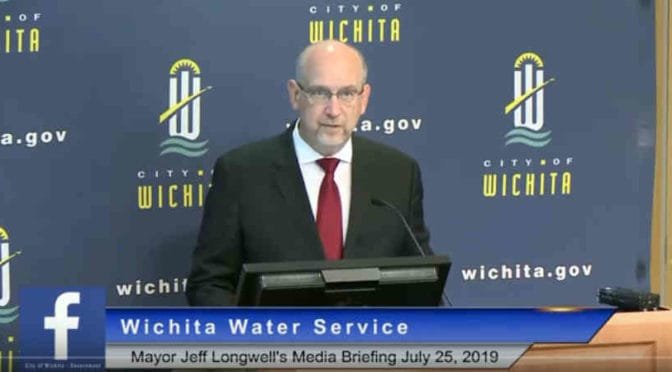
A city hall news event sought to counter a news story that highlighted problems with Wichita’s water supply, but it seemed more like a political campaign event.
In yesterday’s press briefing, Wichita Mayor Jeff Longwell addressed concerns raised in a recent Wichita Eagle article regarding Wichita water infrastructure. 1
Longwell pushed back against the article’s reporting, perhaps the most concerning being: “Wichita’s entire water system has a ‘significant risk’ of failure and lacks redundancy, meaning if a major asset fails, it can’t be fixed without shutting the whole plant down.” The article also reported, “Deferred maintenance has piled up over the years.”
The mayor presented an infographic produced by the city showing steps the city has taken since 2011 to maintain existing water infrastructure and prepare for the future. (Curiously, this is available on the city’s Facebook page but not at wichita.gov, the city’s website.) According to him, the city has been managing the city’s water needs effectively.
This, however contradicts a statement the city council issued in 2015, when Longwell was mayor. As part of the Wichita-Sedgwick County Community Investments Plan, the city council concluded: “Decades of under-investment and deferred maintenance in Wichita’s water, sewer and stormwater infrastructure requires the City to be aggressive in protecting what assets it already has (especially replacing aging pipe infrastructure) and making future water and sewer facility enhancements to meet required treatment and discharge standards.” 2
(Of course, we could conclude that the statement and plan from 2015 doesn’t have any real meaning, which if true, causes me to wonder why we undertake these exercises.)
The mayor also addressed the 2014 proposed Wichita city sales tax, $250 million of which was earmarked for a water project. The mayor correctly explained that that money was not to repair existing infrastructure or build a new main water processing plant. Instead, it was to expand the Aquifer Storage and Recovery system and build an additional pipeline from it to the city. That would have provided what the city called “drought protection.”
It’s important for Longwell to explain that the 2014 sales tax, if it had passed, would not have addressed the issues with the current water plant. This is important because Longwell voted against the sales tax. If today’s voters thought the 2014 sales tax would have fixed the water plant and saw that Longwell voted against it, that might be a negative factor against Longwell.
Which brings us to the final point. The press conference was a thinly disguised campaign event for the mayor, conducted using city facilities and staff, complete with a cartoon-like infographic. If the information is important, the city should present it plainly, not in a cumbersome graphic spread three panels wide that the mayor can post on Facebook and Twitter.
Wichita Eagle reporting on this event is at Wichita on track for new water plant in 5 years, city says.
—
Notes
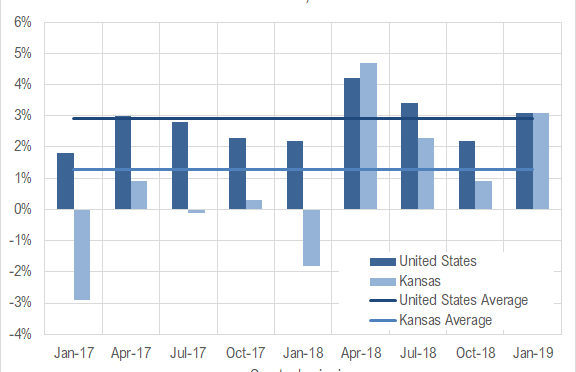
In the first quarter of 2019, the Kansas economy grew at the annual rate of 3.1 percent, up from 0.9 percent the previous quarter.
In the first quarter of 2019, the Kansas economy grew at the annual rate of 3.1 percent in real (inflation-adjusted) dollars, according to statistics released today by Bureau of Economic Analysis, a division of the United States Department of Commerce. GDP for the quarter was at the annual rate of $171,215 million.

The rate of 3.1 percent ranked twentieth among the states and matched the rate for the entire nation.
Quarterly GDP growth for states can be volatile, as shown in the chart.
Over the last eight quarters, Kansas has averaged quarterly growth rates of 1.3 percent in annual terms. For the nation, the rate was 2.9 percent. For the Plains states, it was 2.0 percent. (For this data, BEA defines Plains states as Iowa, Kansas, Minnesota, Missouri, Nebraska, North Dakota, and South Dakota.)
For Kansas, industries that performed substantially better than the nation include agriculture, durable goods manufacturing, durable goods manufacturing, retail trade, and management of companies and enterprises.

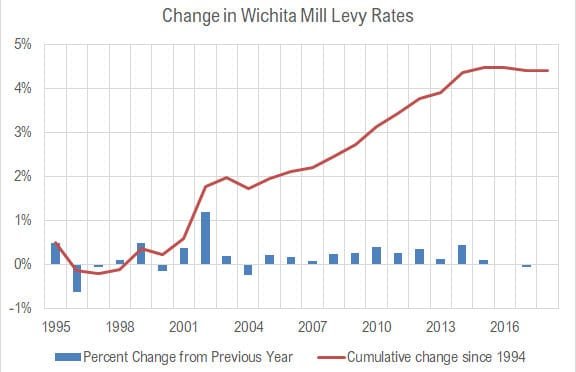
The City of Wichita property tax mill levy was unchanged for 2018.

The rate for 2018 was unchanged from 2017 and follows two years of small decreases.

While the city council doesn’t have control over the assessed value of property in its jurisdiction, it does have control over the amount it decides to spend. As can be seen in the chart of changes in the mill levy, the city usually decides to spend more than the previous year’s mill levy generates in taxes. Therefore, tax rates usually rise.

An increase of 4.40 percent over more than two decades may not seem like much of an increase. But this is an increase in a rate of taxation, not tax revenue. As property values rise, property tax bills rise, even if the mill levy rate is unchanged.
The total amount of property tax levied is the mill levy rate multiplied by the assessed value of taxable property. This amount has risen, due to these factors:

in 2018 the city budget held this regarding the debt service fund: “In both 2013 and 2014, 0.5 mills were shifted back to the Debt Service Fund.”
Following, a chart and table showing the taxes paid to the City of Wichita for a hypothetical home. This includes changes in the value of the home (based on U.S. Federal Housing Finance Agency, All-Transactions House Price Index for Wichita, KS (MSA) [ATNHPIUS48620Q]) and inflation (based on Consumer Price Index Series II: CUUR0000SA0, U.S. city average, All items, Base Period 1982-84=100, Bureau of Labor Statistics). Click for larger versions.

In 2014 Wichita voters rejected a sales tax which would have provided $250 million to spend on a water project. What were the city’s concerns?
A recent Wichita Eagle article has ignited some revising of history regarding Wichita’s water infrastructure. 1 The article is grim, starting with, “Next time water comes out of your tap, don’t take it for granted. Wichita’s only water treatment plant could fail at any moment.” The article reports on the poor condition of Wichita’s existing water infrastructure, particularly the central water plant.
Wichita recently dealt with spending on a water project. That was in 2014, when the city asked voters to decide on a one cent per dollar sales tax for five years. Of the estimated $400 million the tax would raise, $250 million was earmarked towards water infrastructure. Since voters did not endorse the tax, some have blamed voters for the city’s current problems regarding water infrastructure.
Here, for example, is a social media exchange on Monday. The first person wrote, referring to Wichita Public Works Director Alan King, “Mr King is only now sounding a warning when he knew 8 years ago there was a problem?”
A second person responded: “Wrong Wrong Wrong. King has been yelling about this since he got here. Remember the temporary sales tax for the water where the citizens obeyed the Billionaire and his million dollars that said we can take the risk?”
To understand the errors in the second person’s comment, we need to understand the meaning of “for the water” and “the risk.” City documents have the answer.
A Wichita city white paper from May 2014 cites a community survey, concluding, “Wichitans have ranked a reliable water supply as their most important priority.” 2 The city interpreted citizens’ concerns are requiring protection from drought: “Protecting water sources during periods of drought is an important part of long-term water supply planning.” The paper presented “two options meet the goal of providing water for community growth and drought protection.” One option was using water from El Dorado Reservoir, and the second was expanding the ASR system. This paper does not mention the condition of existing water infrastructure.
On May 27, 2014 City Manager Robert Layton presented to the city council a “Strategic Plan Follow Up,” providing information about the possible uses of the proposed city sales tax. 3 For water issues, the only consideration was drought protection.
In July 2014, the city prepared a document titled “Strategic Plan Implementation Timetable.” 4 Regarding water, the activity needed was:
1. Develop a plan that addresses:
A. New water sources
B. Conservation strategies
C. Reuse opportunities for industry
D. Emphasize water as a priority with the State and Congressional delegation
E. Work with area communities to ensure water is also a priority for them
The long-term objective for water was: “Secure sufficient capacity from two identified options to provide water that supports the long-term growth of Wichita while protecting water users from future droughts. Implement cost-effective conservation strategies that complement water source capacity.”
Under measurements of success there were these items:
Year of final protection in a 1% drought without additional conservation efforts (target is 2030).
Variance in firm yield compared to demand in 2060 (target is 0%).
Volume of water treated (target is 20.8 billion gallons per year).
Annual water reductions from conservation programs (target is 0.35%).
Water conservation program cost to achieve water reduction goal (target is $300,000 annually).
None of this material mentions the condition of existing water infrastructure.
In September 2014 the city published a document titled “Water Supply Plan: The Proposed 1-cent Sales Tax.” 5 under “Plan Summary,” the document states: “Sales tax revenue would fund a new water supply, through Aquifer Storage and Recovery (ASR) improvements. This new supply would reduce the impact of any future drought and would support job growth.”
Later, the document says the plan does the following:
Pulls more water from the Little Arkansas River
Constructs new storage basins
Further utilizes existing treatment plant capacity
Stores treated water underground where it doesn’t evaporate
Builds an additional pipeline
The document clarifies that the “additional pipeline” is a “parallel pipeline” from the ASR plant to the central water plant.

An information sheet prepared for citizens said the same and warned of the costs of borrowing to pay for these facilities. 6
A lengthier presentation prepared for voters by the city held this:
THE NEED
Demand for water is expected to increase by more than seven billion gallons per year by 2060. A new water supply is needed to meet this demand. If the community should experience a significant drought, residents would face severe water restrictions.” 7
From these city documents, we can understand the error in the second commenter’s remarks. In the context of 2014, taxing and spending “for the water” meant expansion of supply, not maintenance of existing assets.
Further, in 2014 “the risk” that was to be addressed was the risk of water use restrictions in case of an extended drought. The risk of basic water plant infrastructure failing was not considered or addressed in the city’s plan for spending $250 million on a water project.
—
Notes
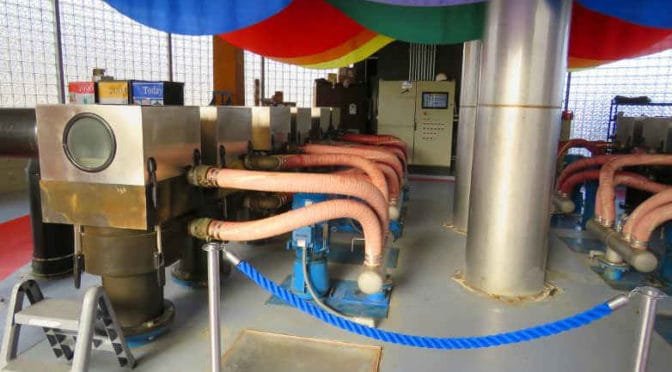
New research explains what you may have wondered: What is tax “decrement” financing?
Wichita has a financing mechanism known as the Gilbert-Mosley tax decrement fund. I knew about tax increment financing, but I never really understood how tax decrement financing worked. I had thought that in this context, “decrement” had a sophisticated meaning that I wasn’t able to understand because I wasn’t smart enough, or I hadn’t tried hard enough, or I didn’t have the correct documents to read.
Now, Chase M. Billingham and Sean Sandefur have published detailed research that explains how the Gilbert-Mosley financing works. Billingham is Assistant Professor of Sociology at Wichita State University. Their research, which forms a chapter of the book Tax Increment Financing and Economic Development, Second Edition: Uses, Structures, and Impact, is titled “The Conceptual Pliability of TIF and the Political Rhetoric of Environmental Remediation: Groundwater Pollution and Tax “Decrement” Financing in Wichita.” You may download a pdf of the chapter by clicking here. The published chapter had to be cut for length, but this pre-print version provides much greater detail than the published version.
Following, an introduction to the research by Billingham:
If you ask people around Wichita why growth in the city’s downtown core has been so slow over the past several decades, you’re likely to hear that one of the main culprits was a terrible problem with groundwater pollution in the 1980s and 1990s. You’re also likely to hear about the miraculous and innovative home-grown response that Wichita came up with to solve this problem. This solution involved using tax-increment financing to fund the groundwater cleanup operation, keep Downtown Wichita from becoming a massive Superfund site, and save the city’s core from turning into a “ghost town.”
Despite the local mythology that has been built up around this operation, neither the history of Wichita’s groundwater problem nor the financial mechanisms that were implemented to address it are well understood by the public.
That’s the focus of a new piece of research published this month as a chapter in a new edited volume – Tax Increment Financing and Economic Development: Uses, Structures, and Impact (SUNY Press). In this chapter, my coauthor Sean Sandefur and I explain the history of Wichita’s downtown groundwater crisis, the politics behind the creation of the local taxing district established to fund the cleanup, and the financial mechanisms that are still in place today to direct money toward the cleanup fund.
Although this has consistently been referred to as a novel use of tax-increment financing, we reveal that the actual structure that was implemented is not an example of TIF at all, but rather a simple diversion of a constant flow of property tax dollars into a special fund, with no relation whatsoever to fluctuations in underlying property values and assessments.
The idea of “TIF” is so poorly understood, so vague, and so frequently subject to mystical ideas about projects “paying for themselves” that it can be used as a convenient label to mask how local governments actually engage in public finance. The results of this research are applicable for thinking about a wide range of downtown development projects currently underway in Wichita, as well as other cities.